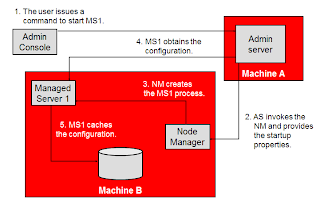Node
Manager Architecture
The
diagram illustrates the relationship between a Node Manager, its clients, and
the server instances that it controls. A Node Manager client can be local or
remote to the Node Managers with which it communicates. You can access either
version of the Node Manager—the Java version or the script-based (SSH)
version—from the following clients:
•Administration Server: Administration Console, from the
Environments > Machines > Configuration > Node Manager page
•JMX utilities
•WebLogic Scripting Tool (WLST) commands and scripts:
WLST offline serves as the Node Manager command-line interface that can run in
the absence of a running administration server. You can use the WLST commands
to start, stop, and monitor a server instance without connecting to an
administration server. Starting the administration server is the main purpose
of the stand-alone client. However, you can also use it to:
-Stop
a server instance that was started by a Node Manager
-Start
a managed server
-Access
the contents of a Node Manager log file
-Obtain
the server status for a server that was started with a Node Manager
-Retrieve
the contents of the server output log
How a
Node Manager Starts an Administration Server
The
diagram in the slide illustrates the flow of a Node Manager starting an
administration server.
1. An
authorized user issues the WLST offline command, nmConnect,
to connect to the Node Manager process on the machine that hosts the
administration server. The authorized user then issues a command to start the
administration server. (If the Node Manager instance is the SSH version, the
user can connect using the SSH client.)
2. The
start
command identifies the domain and the server instance to start, and in the case
of the Java Node Manager, provides the Node Manager username and password.
3. The
Node Manager looks up the domain directory in nodemanager.domains,
and authenticates the user credentials using a local file that contains the
encrypted username and password.
4. The
Node Manager creates the administration server process.
5. The
administration server obtains the domain configuration from its config
directory.
How a
Node Manager Starts a Managed Server
The
diagram in the slide illustrates the flow of a Node Manager starting a managed
server.
1. From
the Administration Console, the user issues a start
command for Managed
Server 1.
Server 1.
2. The
administration server issues a start
command for Managed Server 1 to the Node Manager on Machine B, providing the
remote start properties that are configured for Managed Server 1.
3. The
Node Manager starts Managed Server 1. The Node Manager starts the managed
server using the same root directory where the Node Manager process is running.
To run the managed server in a different directory, set the Root Directory
attribute on the Server > Configuration > Server Start Console page.
4. Managed
Server 1 contacts the administration server to check for updates to its
configuration information.
5. If
there are outstanding changes to the domain configuration, Managed Server 1
updates its local cache of configuration data.

